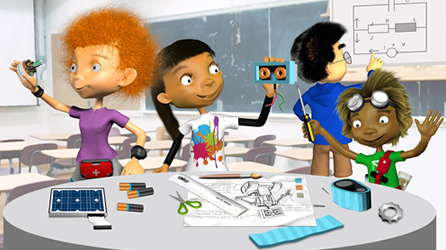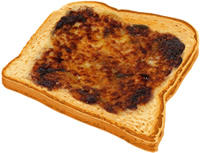When was the last time you thought about your thinking? It sounds like a strange thing to do, but thinking is an important skill.
Below you will find the following information about being a critical and creative thinker and a bit about intellectual property:
- Thinking critically and creatively
- Approaching problems and challenges
- A five-step problem solving process
- Creative thinking Aussies
- International innovations
- Protecting your ideas
- References
Thinking critically and creatively

Are you a critical or creative thinker? Are you good at solving problems or challenges? Many people are great at this, but for others it takes practise. So what does it mean to think critically?
When you think critically, you generate and evaluate knowledge, clarify concepts and ideas, seek possibilities, consider alternatives, and work to solve problems. Thinking critically requires you to slow down and think in a way that is purposeful and productive. It requires you to interpret, analyse, evaluate, explain, sequence, reason, compare, question, infer, hypothesise, appraise, test and generalise.
Sometimes we might just want someone to tell us the answer to a problem or challenge, but that doesn’t help us to develop the thinking skills we need at school and in life today and into the future.
Approaching problems and challenges
When you are faced with a challenging problem it is easy to throw your hands in the air and say it is all too hard, but here are some tips (not in any particular order) that might help you develop a problem solving mindset.
- Work with others
Extra brains mean extra ideas. When we work with others we can discuss our ideas, understanding and challenges and gain the perspectives of other people. - ‘Play with’ the problem
This means looking at the problem from different perspectives and considering lots of ideas, even if they seem ridiculous at first. This type of flexible thinking allows multiple solutions or ideas to be considered and can lead to innovative solutions. - Break the problem into smaller parts.
Sometimes a problem can seem overwhelming, so breaking it into smaller parts allows you to find a starting point and focus on one thing at a time. If you are working in a group, you might even be able to allocate parts to different people. - Don’t focus on getting the one ‘right answer’.
A problem may not have one ‘right’ answer. In fact there may be lots of solutions, so it is important to think about the process and not just the outcome. - Take your time
Unless it is an emergency, you should take your time when solving problems. Make sure that you really understand the problem before you jump right in to solve it. Check what resources you can use and maybe start to brainstorm some ideas (making notes can help) before you get started. - Be prepared to fail
Failure is not necessarily a bad thing. Often, we learn more when we fail at something than when we succeed. If one approach doesn’t work, think about why and then try something else. Persistence and reflection is key. Some very famous problems have been solved after many years of hard work and trial and error.

A five-step problem solving process
This simple, five-step approach might help:
- Define the problem
Make sure you know what you are trying to solve, have the resources you need and know the criteria for success. - Think about it
Ponder the problem, collect information and take your time. - Plan a solution
Consider different strategies and approaches before you select one to develop further. - Carry out the plan
Be patient on this step as many problems take time to solve. You will also need to be persistent; if something doesn’t work try another approach. - Look back and reflect
This is an important step. Once you have found a solution, reflect on the process. Is there anything you would change if you did it again? Does the solution make sense? What did you learn?
Creative thinking Aussies
Australians have been responsible for some amazing inventions including Vegemite, the electronic pacemaker, the Royal Flying Doctor Service, Mortein insect spray, the black box, Ford Ute, the bionic ear, the Victa lawn mower and even WiFi.
Here are some examples of our amazing problem solvers.
Cyril Callister (1893 – 1949) – Vegemite

Cyril Percy Callister was a chemist by trade and in 1922 was hired by the Fred Walker Company (now known as Kraft) to develop a yeast-based spread to find a purpose for left over brewer’s yeast. It was released in 1923 and was not very popular at first, but by the mid-1950s (thanks to the clever ‘We’re happy little Vegemites’ advertising campaign), Vegemite became an Australian icon.
Reverend John Flynn (1880 – 1951) – Royal Flying Doctor Service
Reverend John Flynn was a Presbyterian minister who lived and worked in rural and remote Australia. He set up hostels and hospitals for miners, farmers, road and railway workers and other settlers.
He noticed the daily struggles of the settlers living in very remote areas, but particularly their limited access to health care. In 1928, a good friend of his left Reverend Flynn a large amount of money and he opened the Australian Inland Mission Aerial Medical Service (AIM) in Queensland. His first flight was in a single engine, fabric covered bi-plane, but he soon expanded his service and today it is known as the Royal Flying Doctor Service (RFDS).

Reverend Flynn’s problem solving skills and creative thinking improved the health (and overall lives) of many people in the bush and continues to do so today.
Today, the RFDS provides many services to people who live, work or travel in rural and remote Australia, including:
- 24 hour aeromedical emergency services that can reach anywhere within hours
- telehealth consultations (talking to a doctor on the phone or via the internet)
- fly-in, fly-out doctor and nurse clinics (for small communities)
- mobile dental services
- patient transfers (flying patients from one place to another)
The RFDS want to make sure that people living in remote areas can enjoy the same health outcomes as people living in the city.
J Hagemann (with the Samuel Taylor Company) – Mortein insect spray

Flies (and other insects) can be a big nuisance in Australia, especially in summer.
Mortein insect spray dates back to the 1870s when J. Hagemann (a German immigrant to Australia) became annoyed by the large number of insects bothering him. He put on his creative thinking hat and used crushed chrysanthemum flowers to produce pyrethrum extract which was a natural insect repellent.
Hagemann, and his French wife, came up with the name Mortein for this product. It is a combination of the French word ‘mort’ (dead) and the German word ‘ein’ (one). So Mortein translates to ‘dead one’. Very clever!
Hagemann joined with Samuel Taylor (who owned his own company) to get Mortein onto the market. Originally it was sold as a powder, but in 1953, the Samuel Taylor Company pioneered the aerosol industry in Australia and Mortein was transformed into the spray we know today. Just like the ‘Happy little Vegemites’ ad (read about Vegemite above), the ‘Louie the Fly’ television commercials made Mortein a very well-known Aussie product.
CSIRO – WiFi

WiFi (or wireless network connectivity) is everywhere. In fact, most of us would be lost without it now, but did you know that it is an Australian invention?
While it may not be completely true to say that the CSIRO ‘invented’ WiFi, a team of CSIRO radio astronomers applied their creative and critical thinking skills to devise a solution to slow, impractical WiFi to create the product we have today. This team consisted of Diet Ostry, Graham Daniels, John Deane, Terry Percival and John O’Sullivan. The team had a lot of set-backs and unsuccessful trials of ideas, but they persisted and eventually had a breakthrough.
Now this amazing invention is the most popular way to connect networks and devices without wires. It is used in homes, offices, shops and on the street (sometimes called ‘hot spots’). Well done CSIRO!
International innovations
Now, you know about some amazing Australian inventions, here is some information about global products or ideas that changed the world.
The wheel

It is not known who exactly invented the wheel, but it is thought to have originated around 3,500 BC in Mesopotamia (now the area around Iraq, Syria and Turkey) where it was used by potters and weavers. The potters used the wheels to make pots that could carry water and food. It was not until around 300 years later that wheels were used for transport.
Today we see wheels everywhere and it is hard to imagine life without them. They make it much easier for us to travel and to carry heavy loads. Amazingly, the design of the wheel has not changed much since it was invented. However, today we use different materials than those used by the original potters.
The printing press

The printing press was invented in approximately 1450 by German man, Johannes Gutenberg.
The original printing press worked as follows:
- Each letter was carved into a steel punch which was then hammered on to a piece of copper. This is known as the ‘blank’.
- The blank was inserted into a mould and a mix of lead, bismuth and antimony was poured inside.
- Once this liquid cooled the letter was complete.
- To print something, the letters of the words were arranged into a frame and ink was applied. Then the press could print as many copies as needed.
This took a long time and so printing was only done for books and newspapers that were in high demand (a lot of people wanted them).
The result of this amazing new invention was an increase in the number of books and a decrease in their cost. This meant that information was available to a much larger segment of the population. New ideas could spread quickly and more people wanted to learn to read (before this, reading was not a common skill for a lot of people).
The way that we print has changed a lot since 1450, but imagine our lives without any printed materials.
The telephone

The telephone is one of the most important communication inventions of all time. The invention of the telephone took many years, numerous inventors and a lot of trial and error.
In the 1830s, Michael Faraday began the telephone journey when he proved that vibrations of metal could be converted into electrical impulses (the basic principle of the telephone), but this idea was not developed at that stage. Then, in 1861, Johann Reis (a German inventor) built a product that converted sound to electricity and back again, but it had lots of problems and was not developed any further.
In the 1870s, two men (Elisha Gray and Alexander Graham Bell) were experimenting with ideas at the same time in the United States. After a lot of hard work, they both produced the equipment that would eventually become the first telephone and rushed to protect their idea. Amazingly, they both applied for patents (a protection for your idea) within hours of each other, but Bell beat Gray by two hours and so he is given the credit for inventing the telephone.
As we know, telephones have changed a lot over the last few centuries and we now have Smartphones. Do you wonder if Bell or Gray ever imagined what their invention would become?
The internet

The internet is essentially a network which connects thousands of smaller networks into one global network and many of us take it for granted. However, it is a relatively recent invention.
Unlike some of the inventions mentioned, the internet doesn’t have one single inventor. It started in the United States more than 50 years ago and was used by the government and the military. Scientists and researchers have also used it for years to communicate and share data with each other.
The internet has rapidly changed to the product we have today. When it first became popular, users had to pay by the hour and it would interfere with home phone lines, so no calls could be made while someone was using the internet. It was also a lot slower, with data taking longer to send and websites opening at a much slower rate. Ask an older relative what life was like before the internet and about their experience when it was a new technology.
Protecting your ideas
Coming up with new ideas, inventions or solutions to problems can be fun. Imagine that you are the inventor of a really useful product (or idea) that people will pay for. It makes sense to protect it from being copied, doesn’t it?
Intellectual property (IP) is the property of your mind. It is any productive, new idea that you create. This could be an invention, design, brand or an idea, but it must be something new or original.
If you think you have a new idea, brand or invention, you can apply for an IP right to protect it. This means going through an application process to make sure your idea/product/brand is new or original and, if it is, you can have it protected by law. This means no one else will be able to use it and if they do, you have the right to stop them from copying the idea or product.
If you think you have a great idea, you should be careful about telling anyone about it before you get the IP rights, as they may be able to ‘steal’ it.
If you would like more information about intellectual property and protecting an idea or product, visit IP Australia (www.ipaustralia.gov.au).
So, what are you waiting for? Get thinking!!
References

The following links will direct you to the homepage of the websites used as references for this topic.
- www.ipaustralia.gov.au: www.ipaustralia.gov.au
- www.australiancurriculum.edu.au: www.australiancurriculum.edu.au
- www.csiro.au: www.csiro.au
- www.mortein.com.au: www.mortein.com.au
- www.flyingdoctor.org.au: www.flyingdoctor.org.au
- federation.edu.au: federation.edu.au




